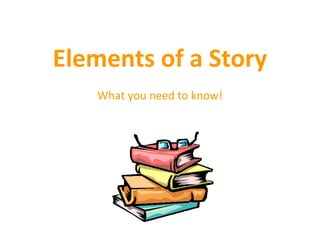
Story elements - LTSM
- 1. Elements of a Story What you need to know!
- 2. A story has five basic but important elements. These five components are: the setting, the characters, the plot, the conflict, and the resolution. These essential elements keep the story running smoothly and allow the action to develop in a logical way that the reader can follow.
- 3. The 5 Main StoryThe 5 Main Story ElementsElements 1. Setting 2. Characters 3. Plot 4. Conflict 5. Resolution
- 4. Setting • Setting is the “where and when” of a story. It is the time and place during which the story takes place.
- 5. SettingSetting Details that describe:Details that describe: FurnitureFurniture SceneryScenery CustomsCustoms TransportationTransportation ClothingClothing DialectsDialects WeatherWeather Time of dayTime of day Time of yearTime of year Time and place are where the actionTime and place are where the action occursoccurs
- 6. The Functions of a SettingThe Functions of a Setting To create a mood or atmosphere To show a reader a different way of life To make action seem more real To be the source of conflict or struggle To symbolize an idea
- 7. Mood • Mood is the feeling that the author tries to convey throughout the story. The atmosphere or emotional condition created by the piece, within the setting. Does the author want the reader to be frightened or sad, or does the story make the reader laugh and think happy thoughts? • To figure out mood, examine how you feel while reading the story. Often mood is conveyed by the story’s setting.
- 8. Characters • The person, animals, and things participating in a story
- 9. Characters • Protagonist and antagonist are used to describe characters. • The protagonist is the main character of the story, the one with whom the reader identifies. This person is not necessary “good”. • The antagonist is the force in opposition of the protagonist; this person may not be “bad” or “evil”, but he/she opposes the protagonist in a significant way
- 10. Plot (or sequence) • Plot is the organized pattern or sequence of events that make up a story. • Plot is the literary element that describes the structure of a story. It shows arrangement of events and actions within a story.
- 11. Parts of a PlotParts of a Plot Exposition - introduction; characters, setting and conflict (problem) are introduced Rising Action- events that occur as result of central conflict Climax- highest point of interest or suspense of a story Falling Action - tension eases; events show the results of how the main character begins to resolve the conflict Resolution- loose ends are tied up; the conflict is solved
- 13. 1.Exposition • This usually occurs at the beginning of a short story. Here the characters are introduced. We also learn about the setting of the story. Most importantly, we are introduced to the main conflict (main problem).
- 14. 2. Rising Action • This part of the story begins to develop the conflict(s). A building of interest or suspense occurs and leads to the climax. Complications arise
- 15. 3. Climax • This is the turning point of the story. Usually the main character comes face to face with a conflict. The main character will change in some way. This is the most intense moment.
- 16. 4. Falling Action • Action that follows the climax and ultimately leads to the resolution
- 17. 5. Resolution • The conclusion; all loose ends are tied up. • Either the character defeats the problem, learns to live with the problem, or the problem defeats the character.
- 18. Putting It All Together 1. Exposition 2. Rising Action 3. Climax 4. Falling Action 5. Resolution Beginning of Story Middle of Story End of Story
- 19. Diagram of PlotDiagram of Plot Setting, characters, and conflict are introduced Introduction / Exposition Development/ RisingAction Climax Falling Action Resolution
- 20. Conflict Conflict is the dramatic struggle between two forces in a story. Without conflict, there is no plot.
- 21. ConflictConflict ConflictConflict is a problem that must be solved; anis a problem that must be solved; an issue between the protagonist and antagonistissue between the protagonist and antagonist forces. It forms the basis of the plot.forces. It forms the basis of the plot. Conflicts can be external or internalConflicts can be external or internal External conflictExternal conflict- outside force may be- outside force may be person, group, animal, nature, or aperson, group, animal, nature, or a nonhuman obstaclenonhuman obstacle Internal conflictInternal conflict- takes place in a- takes place in a charactercharacter’’s minds mind
- 22. Types of External Conflict Character vs Nature Character vs Society Character vs Character Character vs Fate
- 23. Type of Internal Conflict Character vs. Self
